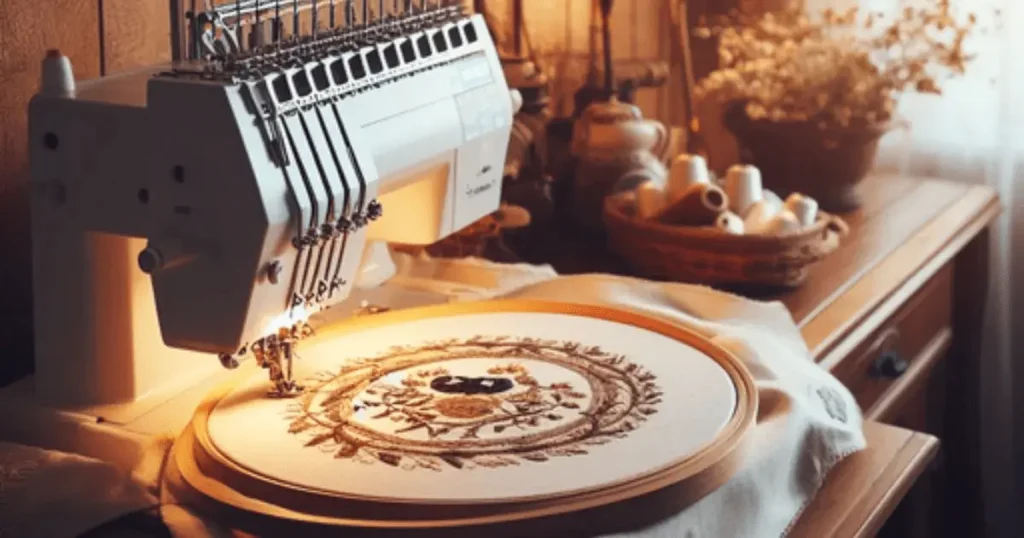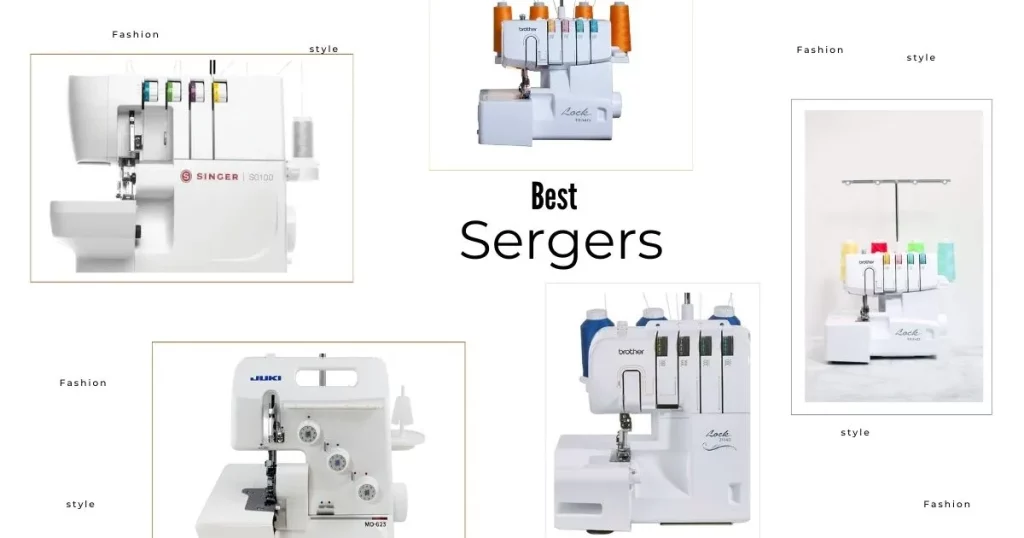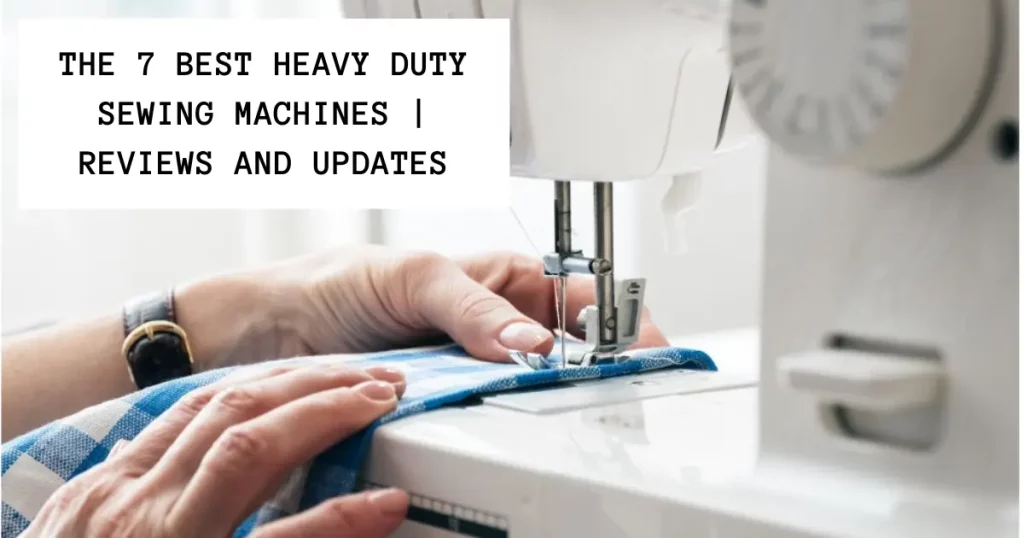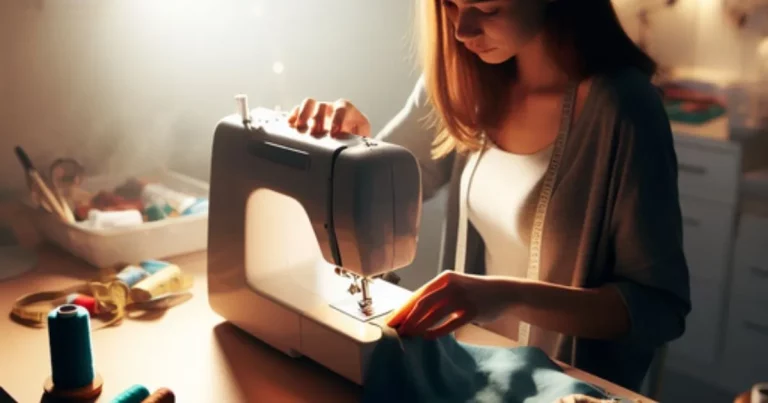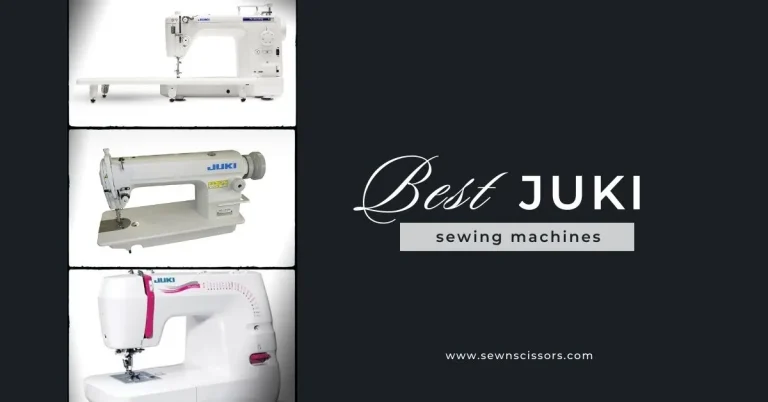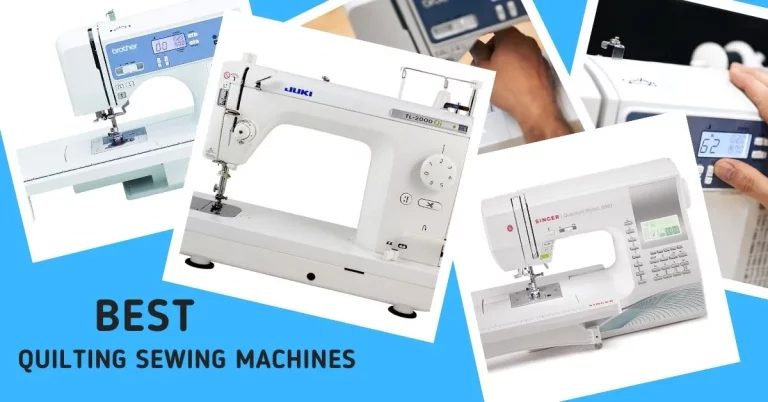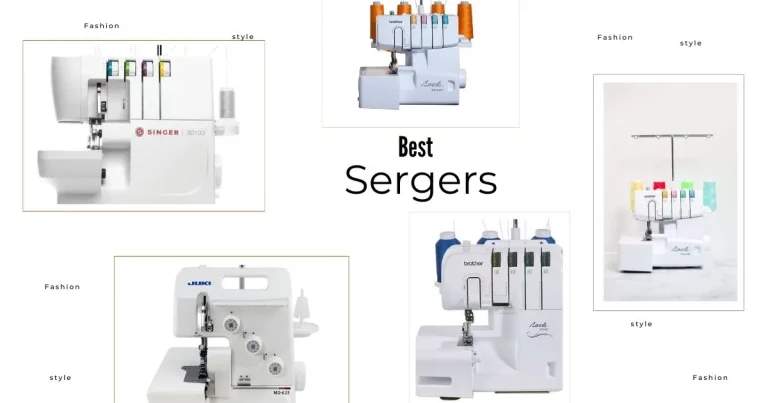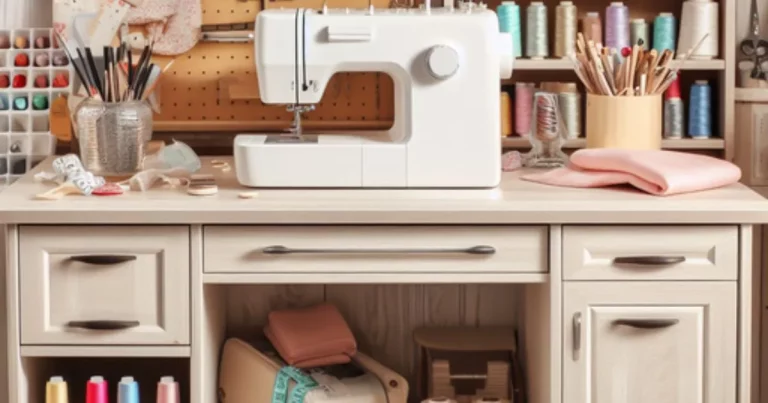8 Best Sewing Machines of 2025 | Tested & Reviewed By Experts
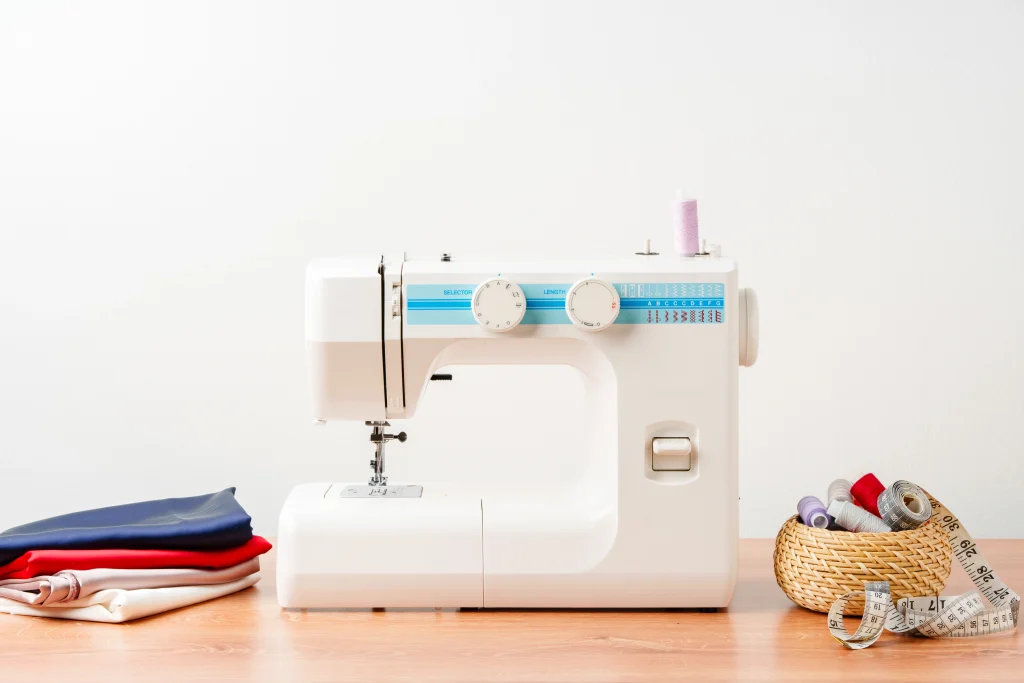
Take our well evaluated list of the 8 best sewing machines and set out on a creative and sewing journey. These sewing machines are the perfect partners for all of your sewing endeavors because they are made for both seasoned artists and aspiring makers, and they have passed rigorous testing to assure optimal performance.
The brands listed here might pay us if you buy their products. But please know, this won’t change how we honestly feel about any item or where it stands on the list. We’re here to give you straightforward and accurate information, so you can find the best sewing machines for your needs.
List of best sewing machines
Here’s a list of 8 best sewing machines according to our sewing experts.
- Best For Home Use – Brother XM2701 Sewing Machine
- Best For Making Clothes – Brother SM3701
- Best For Beginners – Singer Start 1304
- Best For Intermediate Sewers – SINGER M2100
- Best For Kids – Mini Sewing Machine for Children
- Best For Quilting – Juki TL-2000Qi
- Best For Leather – Singer 4411
- Best For Denim – Singer HD6380
TOP PICKS
| IMAGE | PRODUCT | RATING | PRICE |
|---|---|---|---|
|
BEST FOR HOME USE
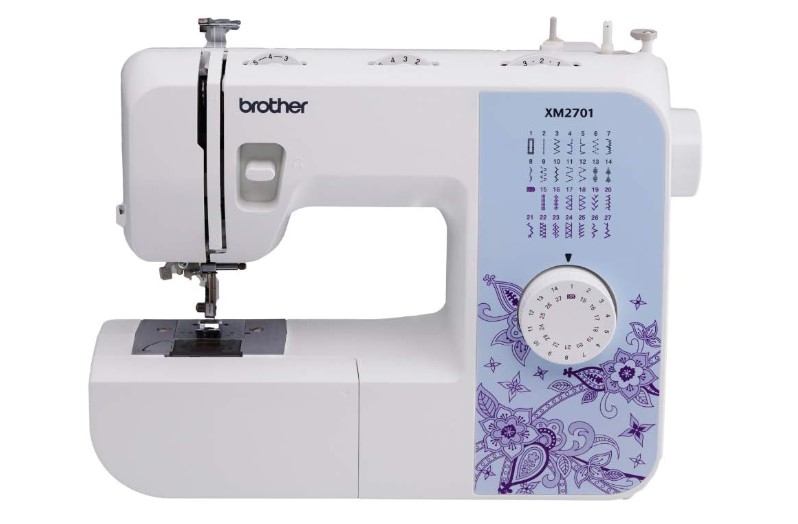
|
Brother XM2701
|
9.7
|
Check on AmazonRead Full Review |
|
BEST FOR CLOTHES
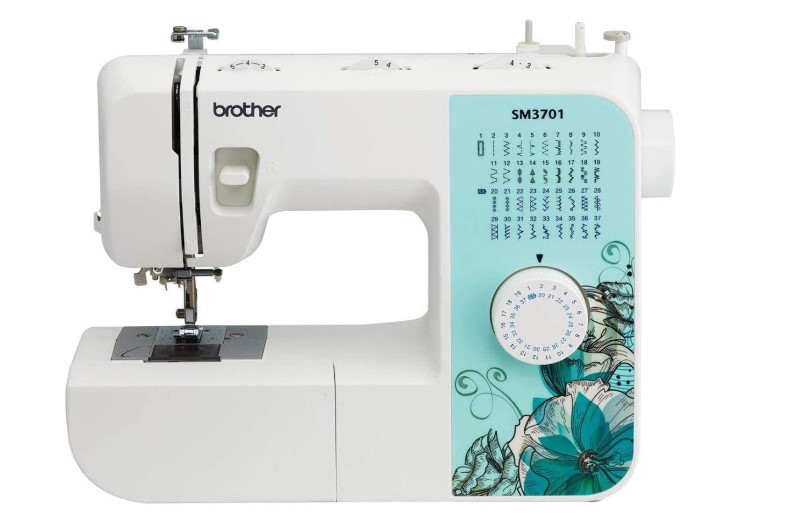
|
Brother-SM3701
|
9.6
|
Check on AmazonRead Full Review |
|
BEST FOR BEGINNERS
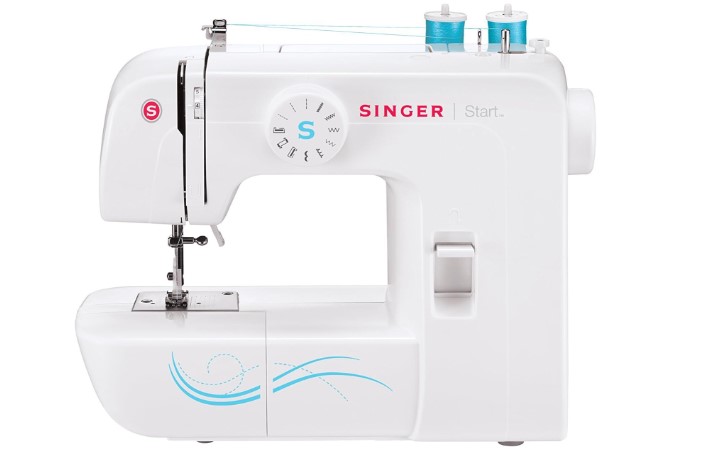
|
Singer Start 1304
|
9.5
|
Check on AmazonRead Full Review |
|
BEST FOR INTERMEDIATE
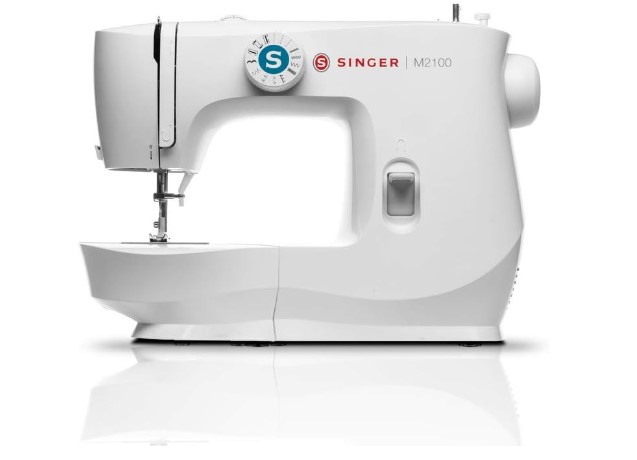
|
SINGER M2100
|
9.5
|
Check on AmazonRead Full Review |
Best Sewing Machine for Home Use – Brother XM2701
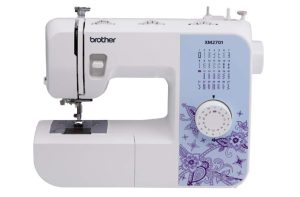
SPECIFICATIONS
Dimensions: 15.3″D x 5.86″W x 12.01″H
Weight: 5.71 kg
Bobbin: top drop in
Built in stitches: 27
Stitch Speed: 800 SPM
Warranty: 25 years limited
KEY FEATURES
1. 27 Stitch options
2. Automatic Threading
3. Comprehensive Accessories
4. Free Arm Design
5. Lifetime technical assistance from Brother.
- Easy for home sewers with automated features.
- Suitable for a wide range of sewing tasks.
- At Your Side assistance for lifelong confidence.
- Easy needle threading and jam-resistant bobbin.
- Light weight and portable
- A very few people have reported the needle threading issue.
Product Review
The Brother XM2701 has undergone rigorous testing by our expert team, ensuring its outstanding performance and reliability. After careful considerations, our team has crowned Brother XM2701 as one of the best sewing machines for home use.
27 Unique Stitches: Tested and approved variety, including decorative, blind hem, zigzag, and stretch stitches.
Effortless Threading: Automatic needle threader for hassle-free threading through the needle.
Jam-Resistant Bobbin: Drop-in top bobbin designed to resist jams during sewing.
Comprehensive Accessories: Comes with 6 sewing feet, 3-piece needle set, twin needle, 4 bobbins, instructional DVD, manual, and more.
Free Arm Convenience: Versatile free arm design suitable for sewing projects of all levels, from beginners to advanced users.
At Your Side Support: Benefit from Brother’s At Your Side support with free technical assistance online, through live chat, or over the phone for the lifetime of your machine.
US Voltage Specification: Specifically designed for sale in the US at 120 volts, ensuring warranty validity.
In short, The XM2701 sewing machine, squarely tested and approved, delivers exceptional performance with its 27 built-in stitches, automatic needle threader, and jam-resistant bobbin and I therefore considered as one of the best sewing machines for home use.
Best Sewing Machine For Making Clothes – Brother SM3701
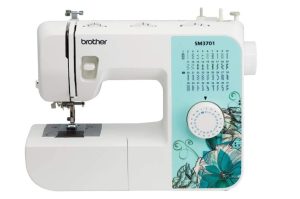
SPECIFICATIONS
Dimensions: 5.8″D x 12″W x 15.3″H
Weight: 5.6 kg
Bobbin: Top drop in
Built in stitches: 37
Stitch Length: 4 mm
Warranty: 25 years
KEY FEATURES
1. Adjustable Stitch Length and Width
2. Built-in Light
3. Easy Stitch Selection
4. Versatile Accessories
5. Free Arm Design
- User-Friendly: Ideal for beginners.
- Diverse Stitches: Sparks creativity.
- Efficient Threading: Simplifies the process.
- Smooth Bobbin Handling: Hassle-free changes.
- Noise Level: Operating noise could be slightly higher compared to more advanced models.
Product Review
In the realm of sewing machines, the Brother SM3701 stands out as a testament to innovation and ease of use. This comprehensive review delves into the machine’s performance, features, and its suitability for both novice and experienced sewers. This sewing machine makes its place as one of the best sewing machines for making clothes, according to experts.
Built in stitch options: The Brother SM3701 boasts a remarkable 37 built-in stitches, offering a diverse range that caters to various sewing needs. From blind hems to decorative and quilting stitches, this machine is designed to handle it all. The automatic one-step buttonhole feature ensures impeccable buttonholes with minimal effort.
Quick-Change Sewing Feet: Included with the SM3701 are five quick-change sewing feet, empowering users with versatility and efficiency. This feature caters to the needs of advanced sewers seeking adaptability in their projects.
Free Arm Convenience: Sewing cuffs, sleeves, and pant legs becomes a breeze with the built-in free arm, providing users with the precision required for detailed and intricate work.
User-Friendly Design: The Brother SM3701 is meticulously crafted with user-friendly features, ensuring a smooth and enjoyable sewing experience. The built-in easy needle threader, jam-resistant mechanism, and quick-set top drop-in bobbin contribute to a hassle-free operation.
Automatic Bobbin Winding: Efficiency is further enhanced with the automatic bobbin winding system, minimizing setup time and allowing users to focus on their creative endeavors.
Comprehensive Package: The package includes an instructional DVD, an English and Spanish user manual, and a 25-year limited warranty. This comprehensive support ensures that users, regardless of their proficiency, can make the most out of their sewing machine.
In short, our experts have considered it as one of the best sewing machines for making clothes, and they are satisfied by its remarkable performance through the sewing journey.
Best Sewing Machine For Beginners – Singer Start 1304
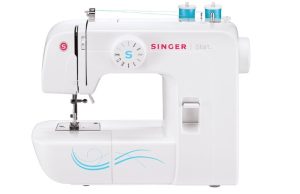
SPECIFICATIONS
Dimensions: 7″D x 13″W x 11.5″
Weight: 4.4 kg
Bobbin: Front load
Built in stitches: 6
Stitch length: 4 mm
Stitch Speed: 350-400 SPM
Warranty: 2yr (motor), 5yr (parts)
KEY FEATURES
1. 57 Stitch Applications
2. Automatic Bobbin Winding
3. Compact and Lightweight
4. Comprehensive Accessories
5. User-Friendly Design
- Easy stitch selection.
- Light weight and easily portable.
- Simplifies setup with automatic bobbin winding.
- Includes various task-specific accessories.
- Limited Stitch selection
- May not suit experienced sewers (suitable for beginners)
- Stability concerns in heavy projects (for lighter project ony).
- Operates at 110 volts only.
Product Review:
The SINGER Start 1304 is a compact and user-friendly device designed for effortless sewing which makes it as one of the best sewing machines for beginners.
User-Friendly Operation: The SINGER Start 1304 sewing machine lives up to its reputation as a beginner-friendly device. With 57 Stitch Applications featuring pre-set stitch width and length, even novices can easily navigate through the stitching options. Selecting a stitch is a breeze, making it an excellent choice for those just starting their sewing journey.
Compact and Portable: Weighing in at a mere 7 pounds, this sewing machine is a dream for users with limited space. Its lightweight and portable design make it perfect for sewing in smaller areas or for those who want to take their machine to sewing classes. The convenience of mobility without sacrificing functionality is a major plus.
Effortless Bobbin Winding: The automatic bobbin winding system of the SINGER Start 1304 adds to its user-friendly features. Following a simple numbered diagram, winding a bobbin becomes a hassle-free task. The automatic stop function ensures that the bobbin is perfectly filled without any manual intervention, streamlining the sewing process.
Comprehensive Accessories Package: The inclusion of essential accessories enhances the overall value of the SINGER Start 1304. From the All-Purpose Foot to the Seam Ripper/Lint Brush, the machine comes equipped with a comprehensive set of accessories. This thoughtful addition saves users from the hassle of purchasing additional items, ensuring they have everything they need to get started.
Durable and Warranty Assurance: Despite its simplicity, the SINGER Start 1304 is built to last. The 25-year limited warranty adds an extra layer of confidence for users. The machine boasts additional features like easy threading, adjustable tension settings, and an extra-high presser foot lifter, making it not only user-friendly but also durable for long-term use.
In short, our evaluation, conducted meticulously by our team, reveals the SINGER Start 1304 as one of the best sewing machine for beginners. These observations are derived from thorough testing, guaranteeing precise evaluations of its features and performance.
Best Sewing Machine For Intermediate Sewers – SINGER M2100
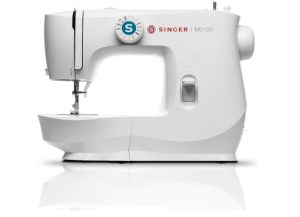
SPECIFICATIONS
Dimensions: 14″D x 17″W x 10″H
Weight: 6 kg
Bobbin: Front load
Built in stitches: 8
Stitch applications: 63
Warranty: 25 years
KEY FEATURES
1. 63 Stitch options
2. User-Friendly design
3. Portable
4. Durable Build
5. Complete Accessories with Presser feet, needles, and more.
- Versatile options for diverse sewing projects.
- Easy stitch selection and quick threading for all skill levels.
- Lightweight design for sewing on the go.
- Internal metal frame ensures stability.
- Design suitable for intermediate sewers
- A very few cases have been reported for difficulty with automatic threader.
Product review:
Our team recently had the opportunity to test the SINGER M2100, and we were impressed by its features and performance. From its versatile stitch applications to user-friendly design, this sewing machine caters to both beginners and experienced sewers. Due its impeccable features it has been selected as one of the best sewing machines for intermediate users.
Design and Portability: The M2100’s lightweight and portable design make it an excellent choice for sewing enthusiasts on the go. Whether you’re attending sewing classes or working in limited spaces, this machine’s compact build ensures easy transportation without compromising functionality.
Stitch Applications: With a remarkable 63 stitch applications, the M2100 covers a wide range of sewing needs. From basic stitches like straight and zigzag to more intricate techniques such as blind hem and decorative scallop, this machine provides the versatility required for various projects.
Easy Stitch Selection: The Stitch Selector Dial simplifies the stitch selection process. Just turn the dial to choose your desired stitch, making it user-friendly for beginners. The preset stitch length and width eliminate guesswork, ensuring a seamless sewing experience.
Buttonhole Functionality: Creating buttonholes is a breeze with the four-step buttonhole feature. The steps are clearly marked on the Stitch Selector Dial, guiding you through the process effortlessly. This feature is invaluable for achieving professional-looking closures on garments and crafts.
Quick and Easy Threading: Threading the M2100 is a straightforward process, thanks to the well-marked threading guides for both the bobbin and upper thread. This user-friendly design minimizes setup time, allowing you to focus more on your sewing projects.
Staybright LED Lighting: The long-lasting LED lighting illuminates the sewing area effectively, reducing shadows and enhancing visibility. This feature is especially beneficial when working on detailed or intricate projects that require precision.
Metal Frame Durability: The internal rigid metal support ensures stability during operation, contributing to the machine’s overall durability. This feature is crucial for maintaining consistent performance over time, even with frequent use.
Reverse Lever Function: The reverse lever allows for easy stitching in reverse, securing seams at the beginning and end to prevent unraveling. This function adds a layer of precision to your sewing, particularly when reinforcing seams.
Included Accessories: The M2100 comes with a range of essential accessories, including presser feet (All-Purpose Foot, Zipper Foot, Buttonhole Foot, Button Sewing Foot), pack of needles, bobbin set, needle plate screwdriver, spool pin felt, seam ripper/lint brush, and a soft-sided dust cover. These accessories provide a comprehensive toolkit for diverse sewing projects.
In conclusion, the SINGER M2100 combines functionality, ease of use, and durability. If you are an intermediate sewer, the 63 stitch applications, preset features, and thoughtful design make it a reliable and versatile choice. The inclusion of essential accessories further enhances its value. The M2100 is not just a sewing machine; it’s a companion that empowers creativity and precision in every stitch. Therefore it has been crowned as one of the best sewing machines for intermediate sewers.
Best Sewing Machine For Kids – Mini Sewing Machine for Children
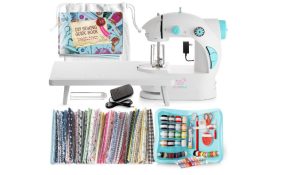
SPECIFICATIONS
Dimensions: 3″D x 6.75″W x 7.9″H
Weight: 0.9 kg
Light: yes
Bobbin: side load
Color: Blue & pink
KEY FEATURES
1. All-in-One Kit means compact machine, essentials included.
2. Easy Start, superb for kids.
3. Versatile Size
4. Portability
5. Handles only lighter fabrics.
- Machine, fabric, and tools for a hassle-free start.
- Built-in features for kids for easy learning.
- Mini size suits kids.
- Portable design for on-the-go creativity.
- 10 diverse ideas in an easy-to-follow guidebook.
- Lacks advanced features for sewers.
Product Review:
Reveal the world of sewing with our meticulously tested Adults & Kids Sewing Machine Kit. This mini sewing machine kit comes fully equipped, ensuring a seamless sewing experience for users of all levels. Due to its portability, light weight and easy to use design, this mini sewing machine is considered as one of the best sewing machines for kids.
Inclusive Kit Contents: Discover a complete sewing experience with our kit that includes a small sewing machine, 50 pieces of 10” x 10” fabric, threaded and spare bobbins, sewing machine needles, spools of thread, sewing clips, thimble, needle threader, seam ripper, scissors, tape measure, chalk pencil, foldable 12” ruler, and a comprehensive guide book.
Beginner-Friendly Features – ideal for kids: Our sewing machine caters to kids with built-in features like a light, foot pedal, adjustable speed, dual power option, and an expandable sewing machine table. The easy user guide ensures a smooth introduction to the art of sewing.
Suitable for Kids- Mini Size, Maximum Convenience: Regular sewing machines can be intimidating, especially for kids and beginners. Our compact sewing machine is tailored for ease of use, making it an excellent choice for both kids and adults venturing into the world of sewing.
Portable Convenience: Craft Anywhere: Experience the freedom to create beautiful handmade projects wherever you go. The portable design of our sewing machine adds convenience to your creative endeavors, whether at home or on the go.
Illustrated Book: Projects for All Ages: Included in the kit is an illustrated book featuring sewing projects for kids, teens, beginners, and adults. With clear instructions and sewing patterns, the book guides users through 10 diverse projects, ensuring a delightful and educational sewing journey.
Overall, due to its these versatile features, it has been considered as one of the best sewing machines for kids, according to our sewing experts.
Best Sewing Machine For Quilting – Juki TL-2000Qi
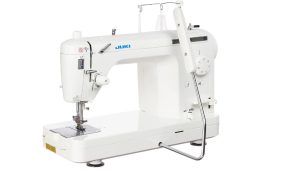
SPECIFICATIONS
Dimensions: 17.8 x 8.6 x 13.8 inches
Weight: 11.5 kg
Bobbin: side load
Stitch Length: 6 mm
Stitch Speed: 1,500 SPM
Warranty: 2yr (motor), 5yr (parts)
KEY FEATURES
1. Automatic Needle Threader
2. Automatic Thread Trimmer
3. High-Speed Sewing
4. Spacious Work Area
5. User-Friendly LED Lights
- Efficient project completion with a high sewing speed.
- Accommodates large projects comfortably.
- Reduce eye strain and enhance visibility with light.
- Convenient automatic thread trimmer and needle threader.
- Ensures long-lasting performance.
- Relatively higher price point compared to some models.
- May be considered too advanced for those with basic sewing needs.
Product Review:
After extensive testing, our team has clearly identified the Juki TL-2000Qi as one of the best sewing machines for quilting overall.
Powerful Performance: The Juki TL-2000Qi boasts an impressive 1500 Stitches Per Minute, making it a powerhouse for quilting projects. The sturdy aluminum die-casting frame ensures stability and durability, providing a reliable foundation for your sewing endeavors. Whether you’re tackling intricate designs or working on large projects, this sewing machine delivers the performance needed to meet the demands of quilting enthusiasts.
Spacious Sewing Area: Experience the freedom of a generous 9-inch sewing space with the Juki TL-2000Qi. Tailored for quilting and home decor projects, this ample workspace allows you to maneuver large quilts with ease. Say goodbye to cramped conditions and hello to a sewing area that accommodates your creative ambitions, providing the room needed to bring your visions to life.
Convenient Illumination: Brighten up your workspace with the built-in LED lights of the Juki TL-2000Qi. Illuminate your sewing area effectively, reducing eyestrain and ensuring you can focus on your craft for extended periods comfortably. The thoughtful inclusion of LED lights enhances visibility, making it easier to work on detailed quilting patterns and ensuring every stitch is precisely executed.
Automatic thread trimmer: Say goodbye to the hassle of manual thread trimming with the Juki TL-2000Qi’s automatic thread trimmer. A simple push is all it takes to snip threads neatly, streamlining your workflow and saving valuable time. This feature is a game-changer, especially during intricate quilting projects where thread management can be a repetitive task.
Automatic needle threading: The automatic needle threader of the Juki TL-2000Qi is designed to get you sewing in no time. Whether you’re a seasoned pro or a novice, this time-saving feature eliminates the frustration of manual threading. Say farewell to squinting and struggling to thread the needle – the automatic needle threader simplifies the setup process, allowing you to focus on your creative expression.
User-Friendly Bobbin System: Experience hassle-free bobbin replacement with the Juki TL-2000Qi’s user-friendly features. The new bobbin case latch and enlarged bobbin area make changing bobbins a breeze, reducing interruptions to your quilting flow. This thoughtful design ensures that even beginners can navigate the bobbin replacement process effortlessly, enhancing the overall user experience.
Overall, our team has rigorously tested the Juki TL-2000Qi, and it has emerged as one of the best sewing machines for quilting. This game-changing device elevates the quilting experience for both seasoned professionals and novices alike. Don’t miss out on the opportunity to enhance your sewing capabilities and take your quilting projects to new heights with this marvel of a machine.
Best Sewing Machine For Leather – Singer 4411
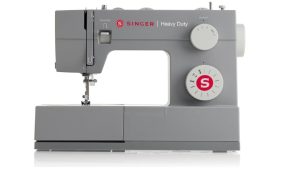
SPECIFICATIONS
Dimensions: 15.5 x 6.25 x 12
Weight: 6.5 kg
Bobbin: Top drop in
Bobbin Class: 15 Transparent
Built-In Stitches: 11
Stitch Width: 6 mm
Stitch Applications: 69
Stitch Speed: 1100 SPM
Warranty: 90 day / 2yr / 24yr
KEY FEATURES
1. Strong motor
2. Top Drop-in Bobbin System
3. Speed and Efficiency with 1100 SPM
4. Spacious Sewing Space
5. Durability and Reliability
6. Compact and Portable
7. 11-built in stitches
- Powerful motor for high-speed sewing
- Adaptable presser foot pressure
- Heavy-duty construction for strength
- Versatile for handling various sewing projects
- Reasonably priced point
- Appropriate for sewing thick and heavy fabrics like leather
- A very few people have reporting the jamming of bobbin.
Product Review:
Our sewing experts have carefully testes and reviewed Singer 4411, and they are pretty sure that this sewing machine is one of the best sewing machines for leather. Let’s talk about the Singer 4411 sewing machine. It’s got a powerful motor that can sew through all kinds of fabrics without breaking a sweat.
69 Stitch options: This sewing machine has a bunch of different stitches – 69 to be exact! That’s a lot, including 11 that come with the machine. You can do all sorts of cool stuff like quilting, making clothes, and adding decorations to your projects.
Easy Buttonholes: Making buttonholes can be tricky, but not with the Singer 4411. It has this cool feature that makes it super easy – just follow four simple steps, and you’ve got a perfect buttonhole.
Easy Thread System with top drop in bobbin: Changing the bobbin is usually a pain, but not with the Singer 4411. It has a top drop-in bobbin system that makes it quick and easy. No more stopping and starting because of bobbin troubles.
Adjustable Stitches: You can change how wide your stitches are with this machine, up to 6mm. So, if you want big stitches or small ones, it’s up to you. Makes everything look just the way you want it.
Super-Fast Sewing: This sewing machine can go really fast – 1100 stitches per minute! That means you can finish your projects in no time and spend more time being creative.
Handy Needle Positions: You can move the needle to different spots with this machine. That’s helpful when you want to make sure your stitches are in just the right place. Great for getting the details right.
Lots of Space to Sew: The area where you sew is big – 6.25 inches from the needle to the tower. So, you can work on big projects without feeling cramped. More space means more fun!
Built to Last: This sewing machine is strong and tough. It’s made to handle heavy-duty sewing, so you can trust it to stick with you for a long time.
Small but Mighty: Even though it’s powerful, the Singer 4411 is not huge. It’s a compact size (15.5 x 6.25 x 12 inches), so you can easily store it or take it with you wherever you want to sew. Its heavy duty motor makes easy for heavy weight fabrics like leather to sew.
Cool Stitches Included: The Singer 4411 comes with 11 stitches already programmed in. They’re like the basic tools you need, from simple stitches for seams to fancy ones for decorations. Each stitch makes your project look awesome.
Overall, our experts say you can experience effortless stitching on diverse fabrics with a powerful motor, versatile stitches, and user-friendly features in a compact design with Singer 4411 for sewing leather, therefore it has been referred as one of the best sewing machines for leather.
Best Sewing Machine For Denim – Singer HD6380
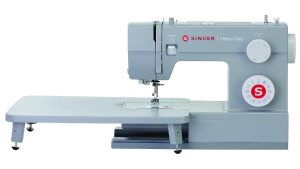
SPECIFICATIONS
Dimensions: 15.5″ x 6.25″ x 12″
Weight: 6.62 kg
Bobbin: Top drop in
Built-in needle threader : Automatic
Adjustable Stitch Width: 6 mm
Built-In Stitches: 32
Stitch Applications: 110
Stitch Speed: 1100 SPM
Warranty: 1 yr / 25 yr
KEY FEATURES
1. Heavy-duty construction
2. 110 stitch applications
3. Automatic needle threader
4. Adjustable stitch width (6mm)
5. 1100 stitches per minute
6. Generous sewing space
7. Soft cover machine cover for protection
- Wide range of stitch applications
- Automatic needle threader
- Adjustable stitch width
- High-speed stitching capability
- Ample sewing space
- Cover included for protection
- Easy stitch selection Dial for convenient operation.
- Relatively heavy for portability.
Product Review
Our team has carefully reviewed the Singer HD6380 sewing machine, conducting a thorough evaluation based on objective observations and its actual performance. So, after the testing procedure or team has crowned Singer HD6380 as one of the best sewing machines for denim.
Heavy-Duty Construction: The Singer HD6380 is robust and stable, providing a reliable foundation for challenging heavy sewing projects like sewing with denim and jeans or other heavy duty fabrics.
110 Stitch Applications: Explore limitless creative possibilities with a vast selection of stitch options to bring your unique vision to life.
Automatic Needle Threader: Save time and eliminate frustration with the automatic needle threader, ensuring smooth starts to your sewing endeavors.
Adjustable Stitch Width (6mm): Customize stitch width for impeccable results, from delicate embellishments to secure seams.
High-Speed Stitching Capability (1100 Stitches per Minute): Experience swift and efficient sewing without compromising on quality, with a boasting horse speed of 1100 SPM.
Generous Sewing Space: Handle larger projects comfortably with ample room for sewing heavy duty tasks.
Top Drop-In Bobbin with Transparent Class (Bobbin Class 15): Convenient bobbin changes and easy thread monitoring prevent unexpected shortages.
Soft Cover Machine Cover: Keep your Singer HD6380 protected and dust-free with the included soft cover for a pristine machine ready for your next sewing adventure.
Easy Stitch Selection Dial: Navigate through extensive stitch options effortlessly with the user-friendly stitch selection dial, making your sewing experience intuitive and enjoyable.
In short, if you want to inspire your sewing adventures with the Singer HD6380—a powerhouse of precision, speed, and creative possibilities, making every stitch a masterpiece, consider it as your first choice because it is one of the best sewing machines for denim.
Types of Sewing Machines
Choosing a sewing machine is like picking a creative companion—it needs to suit your style, skill, and the projects you dream of making. Let’s break down the key types of sewing machines, so you can find the one that fits your needs perfectly.
Mechanical Sewing Machines
Best for: Beginners, hobbyists, and those who prefer simplicity.
Mechanical machines are the classic workhorses of the sewing world. With dials and levers controlling stitch length and width, these machines keep things simple—no screens, no fuss. They’re incredibly reliable for basic stitching, alterations, and repairs.
Expert tip: If you love the tactile feel of sewing and don’t need fancy stitches, a mechanical machine offers durability and ease without overwhelming you with tech.
Computerized Sewing Machines
Best for: Intermediate to advanced sewists seeking precision and versatility.
Imagine a sewing machine that remembers your favorite stitches, adjusts tension automatically, and even tells you which presser foot to use. That’s the beauty of computerized machines. With an LCD screen and hundreds of built-in stitches, these machines open up endless creative possibilities.
Real-world story: I once upgraded to a computerized model after years with a mechanical machine, and the difference was night and day—suddenly my buttonholes were flawless, and quilting became a breeze.
Embroidery Machines
Best for: Crafters passionate about monograms, logos, and decorative designs.
Embroidery machines are designed specifically for embellishment. They stitch intricate patterns onto fabric with precision, and many models let you import your own designs via USB or Wi-Fi.
Pro tip: If you plan to start a small business selling personalized items, investing in an embroidery machine can add incredible value to your offerings.
Overlocker (Serger) Machines
Best for: Those who want professional-quality seams and garment finishing.
A serger trims the fabric edge and encloses it in thread all in one pass, creating clean, stretchy, and fray-resistant seams. It’s a must-have if you work with knits or want your clothes to look store-bought.
Sewist insight: The first time I used a serger, it felt like magic—no more unraveling seams, and my handmade clothes suddenly had that polished, professional look.
Heavy-Duty Sewing Machines
Best for: Sewists tackling thick fabrics like denim, leather, or canvas.
These machines are built like tanks, with stronger motors and metal interiors that power through tough materials. They’re ideal for crafters making bags, upholstery, or outdoor gear.
Expert note: If you find your current machine struggling with thicker fabrics—jamming or skipping stitches—a heavy-duty model could be the upgrade you need to expand your creative horizons.
Each type of sewing machine is designed with a purpose in mind. Whether you’re a beginner dreaming of simple projects or an experienced maker ready to tackle bold designs, the right machine can make all the difference. Think about the projects that excite you most, and let that guide your choice—you’ll thank yourself with every stitch.
Maintenance Tips to Keep Your Sewing Machine in Top Condition
Imagine you’re midway through a project—the fabric flows perfectly, your stitches are crisp—and then, suddenly, your machine jams. It sputters, skips, or worse… stops. Most of the time, the culprit is not a mechanical failure, but neglected maintenance.
Treat your sewing machine like the trusted tool it is, and it will reward you with smooth performance for years to come. Here’s how to keep it running like new:
- Clean It Regularly
- Dust and lint are your machine’s silent enemies.
Every time you sew, especially with fluffy threads or fabrics like fleece, tiny fibers build up in the bobbin case, feed dogs, and under the throat plate.
How often should you clean your sewing machine?
- After every few projects or whenever you switch fabrics.
- More frequently, if you’re quilting or working with high-lint materials.
Expert tip: Use a small lint brush, not canned air. Canned air can push debris deeper into the machine’s inner parts.
Story insight: I once had a beginner student bring me her “broken” machine—turns out it just needed a deep clean. Ten minutes later, it was humming like a song.
Oil It (If Your Machine Requires It)
Not all sewing machines need oiling—check your manual first.
For machines that do, a few drops of sewing machine oil in the right places can prevent wear and reduce friction.
Where to oil:
- Typically, the shuttle hook or moving metal parts are under the bobbin area.
- Never use household oil—it attracts dust and can gum up your machine.
Pro insight: I make it a ritual—clean on Sunday, oil before Monday’s projects. It’s like a spa day for your machine!
Replace the Needle Often
This is the most overlooked step, yet it makes a massive difference.
A dull or bent needle can cause skipped stitches, snagged fabric, or even damage to your machine. Many sewists wait too long.
Rule of thumb:
- Replace your needle every 8–10 hours of sewing, or with every new project.
- Match the needle type to your fabric (e.g., ballpoint for knits, sharp for wovens).
Quick story: I once struggled with puckered seams on a dress order. After checking everything, I realized the needle was overdue. One switch, and the problem vanished.
Cover and Store It Properly
When not in use, always cover your machine—even if it stays in one spot. Dust, sunlight, and humidity can all affect performance.
Storage tips:
- Use a dust cover or case (soft or hard shell).
- Avoid damp areas or direct sunlight.
If you’re storing it long-term, unplug it and remove the needle and thread.
Get It Professionally Serviced Annually
Even with perfect care, your machine benefits from a yearly tune-up by a professional technician. They can adjust timing, clean internal parts, and spot issues before they become costly repairs.
Sewing machines are marvels of engineering—small adjustments can make a big difference. Treat yours with care, just like you would a car or a kitchen appliance, and it will keep your creative flow going without interruption.
Remember: A clean, well-oiled, and properly maintained machine is not just about longevity—it’s about peace of mind. Because nothing should come between you and your next masterpiece.
Sewing Machine Accessories You Might Need
The magic of sewing isn’t just in the machine—it’s in the little things that go with it. The right accessories can make your work cleaner, faster, and a lot more enjoyable. Whether you’re a beginner setting up your first sewing corner or an experienced sewist refining your craft, knowing which accessories to have on hand can save you countless hours of frustration.
Let’s explore the essential tools that make a big difference.
Presser Feet: Your Machine’s Secret Weapon
Presser feet are like specialized assistants for your sewing machine—each one tailored to a different task. Switching them out is like handing your machine the perfect tool for the job.
Must-have presser feet:
- Zipper foot: For neat zippers and piping.
- Walking foot: A game-changer for quilting and slippery fabrics.
- Buttonhole foot: Makes uniform buttonholes in seconds.
- Blind hem foot: For professional-looking hems.
I remember struggling with wavy seams on knit fabric until I discovered the walking foot. It was like sewing on autopilot—no bunching, no slipping. That one swap made me fall in love with stretch projects again.
Bobbins: Small but Mighty
You’ll need extras—trust me. Bobbins run out fast mid-project, and having pre-wound backups for your go-to threads saves time and energy.
Pro tip: Always use the correct bobbin style for your machine model, and never mix plastic and metal bobbins unless your machine allows it.
Expert insight: Organize them by color or project in a bobbin case to avoid tangles. A simple $5 organizer can save you an hour of rewinding chaos.
Extension Table: Give Your Fabric Room to Flow
If you’re quilting or working with large pieces, an extension table adds a stable surface so your fabric doesn’t pull or sag. It helps prevent wonky seams and gives you more control during long stitches.
Why it matters:
Less drag = straighter seams and smoother free-motion quilting.
Needle Types: The Right Point for the Right Fabric
Many sewing problems—skipped stitches, puckering, fabric holes—start with the wrong needle. Investing in the right needle types will drastically improve your stitch quality.
Common needle types:
- Universal: Every day sewing on woven and knit fabrics.
- Ballpoint: Ideal for knits—won’t snag or tear fibers.
- Jeans/Denim: Thicker shaft for heavy fabrics.
- Microtex: Super sharp for fine or delicate fabrics.
- Embroidery & Quilting needles: Specialized tips to handle dense or decorative stitches.
Our Expert’s confession:
Once, while working on satin, I used a universal needle and couldn’t figure out why the fabric was snagging. A quick switch to a Microtex needle turned my nightmare into a dream.
Seam Ripper: The Most Used (and Loved) Tool
No matter how experienced you are, mistakes happen. A good-quality seam ripper helps you undo without damaging your fabric. Keep one close—you’ll use it more than you think.
Thread Snips and Scissors
Sharp, dedicated tools for trimming threads and cutting fabric cleanly. Don’t use your sewing scissors on paper—it dulls the blades!
Extra Accessories Worth Considering
- Thread stand: Helps with smoother thread feed from large spools.
- Spool caps: Keep the thread from tangling or bouncing.
- Magnetic pin holder: A safer and faster way to grab pins mid-sew.
- Knee lift (for advanced machines): Hands-free presser foot lifting—fantastic for precision work.
You don’t need everything at once. Start with the basics—bobbins, presser feet, the right needles—and add tools as your projects demand them. Over time, you’ll build a toolkit that makes your sewing experience smoother, more professional, and way more enjoyable.
Remember: The right accessories don’t just support your machine—they support your creativity.
Common Sewing Machine Problems & Quick Fixes
Every sewist—whether they’re threading their first needle or finishing their fiftieth quilt—eventually runs into sewing machine hiccups. The good news? Most issues have quick, simple fixes you can try at home without calling in a technician.
Let’s walk through the most common problems and how to fix them like a pro.
Thread Bunching Under the Fabric (aka “Bird’s Nesting”)
What’s happening:
You’re stitching along when suddenly there’s a tangle of thread snarling underneath. This messy buildup usually signals a problem with the top thread, not the bobbin, despite how it looks.
Quick fix:
- Rethread the top thread completely (with the presser foot UP!).
- Make sure the thread is securely in the tension disks.
- Double-check that the bobbin is inserted correctly and spinning in the right direction.
Pro tip: Always thread your machine with the presser foot up. It opens the tension discs, ensuring the thread seats properly.
Sewist story:
I once had a student blame her brand-new machine for messy stitches. Turned out she’d threaded it with the presser foot down every time. We fixed it in 60 seconds, and she finished her skirt by lunch.
Skipped Stitches
What’s happening:
The needle moves, but the fabric shows uneven gaps—or no stitch at all.
Common causes:
- Dull, bent, or wrong needle for the fabric
- Incorrect threading
- Tension is too tight or too loose
Quick fix:
- Replace the needle with a fresh one (and match the type to your fabric).
- Rethread the machine from scratch.
- Adjust the upper thread tension slightly and test on scrap fabric.
Pro tip: Always keep a stash of new needles—treat them like tires: change them regularly, especially if you’re sewing thick or specialty fabrics.
Bobbin Keeps Jamming
What’s happening:
The machine locks up, won’t feed the fabric, or makes strange clunking sounds.
Quick fix:
- Remove the bobbin and check for lint or thread caught in the case.
- Clean the bobbin area with a small brush (not canned air).
- Rewind the bobbin if it looks loose or uneven.
Extra tip: Never overfill your bobbin. Stop when it’s about 80–90% full to prevent tension issues.
Fabric Isn’t Moving (Stuck in Place)
Possible causes:
- Feed dogs are down (common after quilting or free-motion stitching)
- Presser foot isn’t fully engaged
- Stitch length is set to zero
Quick fix:
- Raise the feed dogs using your machine’s lever or button.
- Lower the presser foot.
- Increase stitch length to 2.5 for standard sewing.
Sewist insight:
Once during a class, a student said, “My machine’s broken—it won’t move!” It turned out she’d accidentally lowered the feed dogs after trying a darning stitch. We had a good laugh, and it’s been her favorite tip ever since.
Thread Keeps Breaking
What’s happening:
The upper thread keeps snapping, often mid-stitch.
Likely causes:
- Tension is too tight
- The needle eye is too small for the thread
- Poor-quality or old thread
- Burrs or damage on the needle or thread path
Quick fix:
- Reduce thread tension slightly
- Use the correct needle size for your thread type
- Replace cheap thread with quality, brand-name thread
- Check for rough spots where the thread might be snagging (like the needle plate or tension disks)
The machine is Making Unusual Noises
What’s happening:
Grinding, clunking, or buzzing sounds can be alarming.
Quick fix:
- Turn off the machine.
- Remove the needle, bobbin, and thread.
- Clean out the bobbin area and rethread the machine.
- Insert a new needle.
- Restart and test on scrap fabric.
If the noise continues, it might be time for professional servicing, especially if it hasn’t been tuned up in over a year.
Final Stitch: Don’t Panic—Troubleshoot!
Sewing machine problems are frustrating, especially when you’re in the zone. But here’s the good news: Most issues aren’t serious. With a little knowledge and a calm step-by-step check, you can solve nearly any hiccup and get back to creating.
My go-to rule: When something goes wrong, rethread everything, change the needle, and clean the bobbin area. That solves 80% of the issues right there.
Because a well-behaved machine means more sewing, less swearing, and a happier creative journey.
How We Chose the Best Sewing Machines
We believe that a sewing machine is more than just a tool—it’s your creative partner. That’s why our review process goes far beyond reading specs or relying on manufacturer claims. We’ve tested, analyzed, and compared each machine with the same care and attention we’d use if buying one for our own studios.
Hands-On Testing for Real-World Performance
We personally tested over 20 popular sewing machines, evaluating them across multiple fabric types from delicate chiffon to thick denim to see how they handle various sewing challenges. Each machine went through a series of tasks, including straight stitching, zigzag, buttonholes, quilting, and decorative stitches. We checked for:
- Stitch consistency & precision
- Speed & noise levels
- Thread tension balance
- Ease of threading & bobbin winding
Expert Involvement & Community Insights
Our review team includes professional sewists, quilting experts, and DIY enthusiasts with decades of combined experience. To add depth, we gathered feedback from real users and online sewing communities, ensuring we reflect what everyday sewists genuinely experience after months of use, not just the honeymoon period.
Key Factors We Prioritized
- Ease of Use – Friendly for both beginners and seasoned pros
- Versatility – Ability to handle a variety of projects and fabrics
- Build Quality & Durability – Strong enough to last years
- Special Features – Automatic needle threaders, built-in stitches, speed control
- Value for Money – Does the price truly reflect the performance?
- After-Sales Support – Warranty, customer service, and available tutorials
Long-Term Durability & Brand Reliability
We didn’t just test for a weekend. We monitored long-term durability and factored in brand reputation, warranty, and repair accessibility, ensuring the machines we recommend are investments that won’t let you down.
Our reviews are unbiased, thorough, and designed to help you find a sewing machine that fits your needs, whether you’re a beginner or a seasoned sewist. We’ve done the hard work so you can sew with confidence.
What to Consider When Buying a Sewing Machine
Imagine this: You’ve got a vision—a flowing dress, a cozy quilt, or maybe your very first pillow cover. You’re full of inspiration, your fabric is ready, but your sewing machine? That’s where the magic either begins or falls apart.
Whether you’re just threading your needle for the first time or you’ve been sewing for years and are craving an upgrade, the right sewing machine is your silent partner in every stitch, pleat, and seam. Choosing wisely can mean the difference between a project that sparks joy and one that ends in frustration.
So, before you dive in, let’s walk through exactly what you need to consider to find the perfect match for your sewing journey.
Types of Projects: What Will You Be Sewing?
Think about the main purpose of your sewing machine:
- Basic garment construction? A simple machine with essential stitches may be enough.
- Quilting or heavy fabrics? Look for a model with strong motor power, a large throat space, and walking feet.
- Embroidery or decorative stitching? You’ll want a machine with built-in embroidery patterns and advanced stitch options.
Pro Tip: A multi-purpose machine may seem tempting, but it’s best to match the machine’s specialty to your primary projects.
Stitch Count & Variety
While you don’t need hundreds of stitches to sew well, it’s important to have the right ones:
- Must-haves: Straight stitch, zigzag, and buttonhole
- Nice-to-haves: Stretch stitches, blind hem, overcasting, and decorative stitches
More stitches mean more creativity and flexibility, but keep in mind: the quality of stitches matters more than quantity.
Motor Power & Speed
The motor power determines how well a sewing machine can handle:
- Thick materials like denim, canvas, or multiple layers
- Extended sewing sessions without overheating
A stronger motor typically means smoother performance and greater durability. Look for a motor wattage of at least 60 watts for general sewing, and higher for heavy-duty use.
Ease of Threading & Bobbin Winding
If you’ve ever struggled with threading, you know how important this is! Today’s best machines often include:
- Automatic needle threaders
- Top-drop bobbins with clear covers
- Easy bobbin winding systems
Portability & Size
Do you attend sewing classes or travel with your machine? Choose a lightweight, compact model (under 15 lbs).
Need a dedicated sewing space? A larger, more stable machine may be worth it for comfort and control.
Build Quality & Durability
Look for a metal interior frame (more durable) versus all-plastic builds. A good sewing machine should feel sturdy and stable, not flimsy or shaky during operation.
Extra Features & Accessories
Check for helpful extras that improve your experience:
- Adjustable presser foot pressure
- Speed control slider
- Free arm for cuffs and sleeves
- Extension table for large projects
Also, consider the included accessories like extra presser feet, needles, and seam rippers—they add value!
Picture this: you’ve just finished a beautiful project—those even stitches, crisp seams, and the proud feeling of creating something with your own two hands. That’s the joy the right sewing machine brings.
Before you make your purchase, pause and ask yourself: Does this machine fit where I am now, and where I want my sewing journey to go next? The perfect pick isn’t just a tool; it’s a creative partner that grows with you, saving you time, money, and those all-too-common headaches.
Choose wisely, and every project from here on out will feel less like a chore—and more like a celebration of your craft.
FAQs About Sewing Machines
Your essential answers to the most common sewing machine questions, based on real user intent and expert guidance.
Read More: Best Quilting Sewing machines
Tips to find the best sewing machines
- Define Your Needs: Clarify your sewing requirements and skill level.
- Check Key Features: Look for essential features matching your sewing projects.
- Test Before Buying: Try the machine for usability and comfort.
- Read Reviews: Gain insights from user experiences.
- Budget Wisely: Set a budget, consider long-term benefits.
Our Final Words
In conclusion, according to experts and thorough evaluations, the Singer HD6380 emerges as the top choice for one of the best sewing machines. Its exceptional craftsmanship, innovative features, and versatility cater to a wide range of sewing needs. However, the individual preference may vary according to personal sewing demands and needs.


